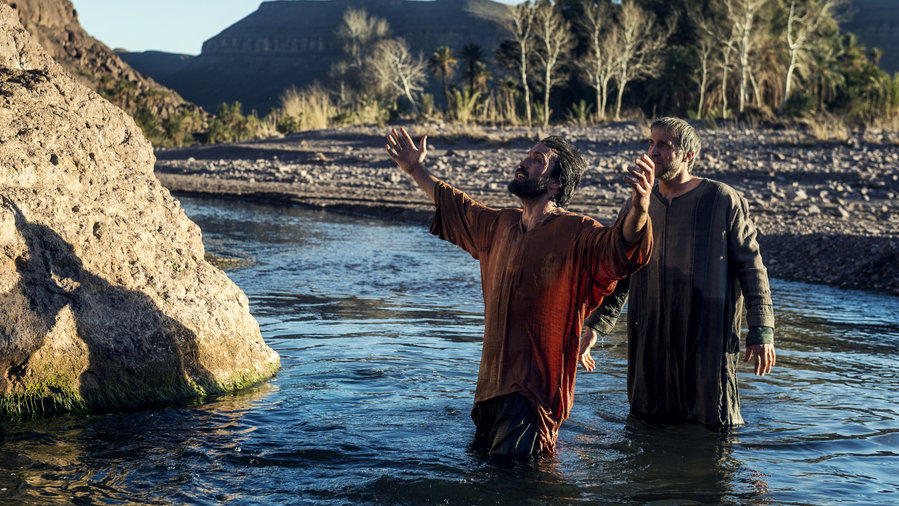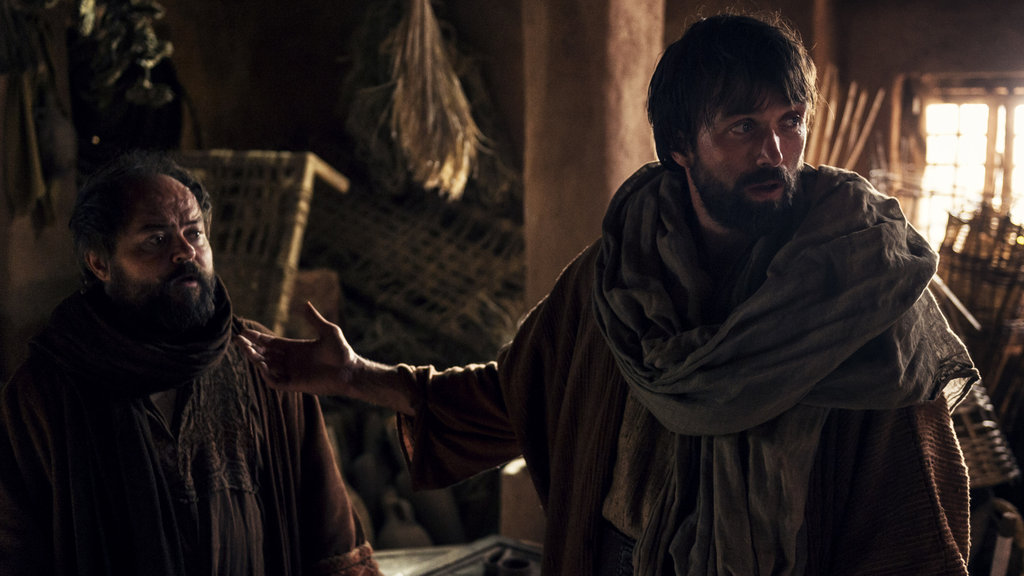
Observations
Three separate plotlines in Acts were dramatized in this episode. And this time the episode title does justice to what is actually in it. The plotline with the most development in this episode is Saul and his experience coming toward and in Damascus (Acts 9:3-20). The second plotline is the political machinations going on in Jerusalem amongst Pilate, Herod, Tiberius and Caligula. The third plotline, and the one that takes a backseat, except for some dramatic sensationalism is Peter, John, and Philip in Samaria with Simon and Magician (Acts 8:14-24).
The bad: the political intrigue storyline has little basis in history. The only part of the plot that remotely comes close to history is that Tiberius might have been murdered by Caligula, or someone under Caligula’s orders. Agrippa was a friend of Caligula, but was most likely in prison during the time the events described here occurred. (For a more authoritative account of Tiberius – see “Tiberius” at Ancient History Encyclopedia.) The rest is pure “fanciful imagination” (echoing Pilate’s character’s words in response to Claudia’s visions). I guess the producers somehow think that Christianity’s threat to Rome has to be developed in this way, by bringing the most important actors into close proximity with one another and with Jerusalem.
The so-so: Peter and John in Samaria as they handle Simon the Magician does follow the biblical text, more than less. The “less” part of following the biblical text is where the episode dramatizes the result of Peter’s condemnation of Simon attempting to purchase the power of the Holy Spirit. What transpires is very similar to what was depicted happening to Ananias and Sapphira when they came under judgment: bleeding from the eyes as they fell to their deaths. In this case though, apparently Peter’s pleading (which is also not in the biblical text, though Simon does request that the apostles plead for his case before the Lord) is heard by God and Simon gets to live. (Again, not in the biblical text – it doesn’t say that Simon suffered anything at all, nor any result if he did.)
The better: Saul’s conversion storyline stays fairly close to the text in Acts. There are extra scenes that attempt to “fill in” what might have been going on with Saul’s disciples that accompanied him, and with Reuben, the temple guard assigned by Caiaphas. I never could find very believable the premises given by this series for Saul’s hatred against the followers of Jesus, and especially Peter. It seemed like a very personal thing, which this episode seems to imply and brings out nearly explicitly: that Saul believed he should have been the specially chosen by God, rather than Jesus. Now the series can stop trying to sell Saul, the persecutor. It has to now sell Saul, the converted and messenger of the gospel.
Sorry, as has been often the case there is nothing in this episode that I would place into the “good” or “very good” categories.
Caiaphas was nearly absent in this episode. Cornelius was completely absent. As was Leah.
Tiberius is right: Pilate really needs to listen more often to and heed his wife’s advice.
Joanna and Chuza are introduced with this episode. Joanna (looking at IMDB) is slated to appear for the remainder of the series. Chuza for the next two. The series assumes viewers know about the mentions of Joanna in Luke 8:3 and 24:10.
For actually going back to the text of Acts and for keeping the main plotline true to the episode title, I give this episode a six of ten (6/10). The historical inventions are quite distracting, however, dragging down my opinions of the series and the episode.
Synopsis
Jerusalem. Temple. Caiaphas orders one of the temple guards to accompany Saul to Damascus to make sure he doesn’t return to Jerusalem before Tiberius leaves.
At Pilate’s residence. Caligula is sleeping after a drunken orgy. Tiberius and Pilate discuss how this is not appropriate behavior for a future emperor. Tiberius does not approve of Caligula’s fraternization with Agrippa. Agrippa is a poor influence on Caligula. Tiberius orders Pilate to wake Caligula and take all involved away before Claudia sees what has gone on. Just then Claudia walks in and is very displeased.
Saul begins his journey to Damascus and discusses taking an accelerated pace. The temple guard wants nothing to do with this; he turns back. A boy overhearing near the gate runs.
The apostles hear from Philip that he needs assistance in Samaria. The apostles are still hiding. Peter comes in with the boy to inform the rest that Saul has left Jerusalem. They are free to come out of hiding and go to Samaria.
Mary Magdalene is serving. Joanna, servant to Herodias, sees Mary. Joanna hasn’t heard yet about Jesus’ resurrection. Mary tells her.
The temple guard catches up to Saul. The guard has secured a horse for himself.
Tiberius asks Claudia what to do with Agrippa. She tells him that Pilate will deal with Agrippa. Tiberius notes how much Claudia works to promote her husband. Tiberius informs Claudia that he is thinking about giving Pilate a position in Rome. Claudia seems pleased, but then sees vultures circling outside the window.
Saul makes camp and spews hatred of Peter amongst his companions. He believes Peter is a snake-oil peddler, who tells people that they have a problem, that they killed a man sent by God, and he has a solution: to repent and to throw themselves into the river. Saul believes in his mission: to stamp out heresy and to prevent the fake cure from spreading. (The apostles leave Jerusalem under cover of night.)
End of segment one.
Pilate comes to where Caligula and Agrippa are resting. But he seems powerless to do anything. He accuses them of meeting the Jewish idea that Romans are degenerate.
Saul continues his travel. The horse balks and throws off its rider. The temple guard must lead the horse on foot.
Pilate is annoyed for not following through on taking Caligula’s life. Claudia asks how long he would survive if he had done that. All he needs to do is keep Caligula and Agrippa separate and their future in Rome will be secure.
Peter and John arrive to see Philip baptizing.
Return to Mary and Joanna. Chuza, Joanna’s husband, enters unexpectedly. He is suspicious of Mary. As they walk, they encounter Agrippa and Caligula. Agrippa tries to take Joanna. Herodias walks by, just in time.
Saul continues to walk on, The guard follows. He wants to know why Saul is so obsessed. Saul can’t accept that God would choose a man from a fishing village to be a Messiah. He can’t understand why God wont’ choose someone articulate, knowledgeable, cosmopolitan, like… Saul doesn’t say, but he clearly thinks it should be someone like him.
A darkness comes over Saul, and a light shines upon him. Jesus appears to Saul in a vision. Saul can’t accept that this is happening. He asks, demands, what Jesus wants. Jesus only tells Saul that he is to continue to Damascus and he will be told what to do once he gets there. Saul is blind.
End of segment two.
Damascus. Saul remains blind. Saul’s disciples discuss how they must continue the mission of rounding up Peter and other followers of Jesus. Barnabas overhears and quickly walks away.
Samaria. Simon the Magician tells his story, of how he was a trickster who started to believe in his own tricks, and then Philip came along. He’s been baptized and wants to work together to spread the gospel and the power of Jesus. A large crowd has gathered because they’ve heard about the miracles in Jerusalem and they want to experience it also.
Barnabas goes to Ananias’ home, where his wife is in labor. Barnabas says he must leave Damascus now, because Saul is here. Ananias challenges Barnabas. If Jesus is so powerful, why does he cower at the first sign of danger? Ananias talks Barnabas into staying, to trust in Jesus.
Samaria. Peter performs miraculous works in Jesus’ name.
Tiberius gives a letter to Pilate that will secure him a job in Rome. Tiberius tells Pilate that Claudia has much wisdom, that he should listen more to her words. Caligula and Agrippa enter and accuse Pilate of machinations that seek to separate the two. Caligula threatens Pilate of making a grave mistake, and insinuates that Tiberius will not always be around to protect him.
Damascus. Saul is wandering about in his blindness.
Tiberius leaves Jerusalem. Caligula hurls accusations and threats against Pilate.
End of segment three.
Samaria. Peter, John, and Philip. Simon gives them a bag of coins. All he wants in return is a bit of the Holy Spirit, to be able to do the miracles that they are able to do. Peter accuses Simon of trying to buy God’s power. Dark clouds form. Peter gets angry and throws the coins at Simon. Simon begins to bleed from his eyes (a lot like what happened to Ananias and Sapphira). Simon claims he repents. Peter begs God for mercy to be shown Simon. The clouds break, but Simon is spared.
Joanna is praying to Jesus. Agrippa overhears, begins to enter, listens and then leaves.
Joanna is having nightmares of vultures. She has a vision of Caligula appearing to be in a position to assassinate Tiberius.
A light shines onto Ananias (in Damascus). He sees a vision of Jesus, directing him to Saul. Ananias protests, but Jesus assures him that Saul is his chosen vessel. Saul seems to have a nightmare of sorts, unwraps the cloth around his eyes and calls out a name: Ananias.
End of segment four.
Ananias comes to the house where Saul is staying. Ananias goes to Saul. He is able to see.
Herod, Herodias, and Agrippa walking. They enter a room, then moments later Joanna and Chuza enter. Herod asks if Joanna is a follower of Jesus. Chuza claims that Joanna is mad. Herod asks Joanna if she is mad. Joanna replies that she was once cured of demons. This response satisfies Herod, who lets them go with a charge to Chuza to control his wife and that no further speaking to Jesus should occur in his house. Agrippa is angry that there were no more repercussions.
Damascus. Saul’s disciples ask what happened. Saul states that he saw Jesus, the Son of God, and that Jesus is here. Saul admits that what he has been doing has been wrong. Saul will go to the river to be baptized. He implores the others to accept Jesus and be baptized.
Caligula suffocates Tiberius in his sleep. Claudia has a nightmare where she sees this. Pilate wakes and asks. Claudia tells him, but he doesn’t believe it. He thinks it is just fanciful imaginations.
End of segment five.
The temple guard begins his return to Jerusalem, echoes of Saul’s words before and after in his mind.
Saul is at the river with Ananias and Barnabas. Barnabas wonders how Saul could hope to be saved when he has the blood of Jesus’ followers on his hands. Saul doesn’t excuse his actions. He just asks for forgiveness. Ananias calls on Barnabas to stop from leaving. How could they deny someone’s request to accept Jesus and be baptized, even if the person is Saul? Saul is baptized. Barnabas seems ready to accept Saul.
The temple guard, Reuben, returns to Caiaphas with the nightmare that Saul is now a follower of Jesus.
Saul heads straight to the synagogue where he begins to preach Jesus.
Pilate is preparing to leave Judea. He has nominated Antipas as his successor. Claudia warns that things could change. As they enter the official room, they are startled to see Caligula. He informs those present that Tiberius is dead. Caligula is the new emperor.















